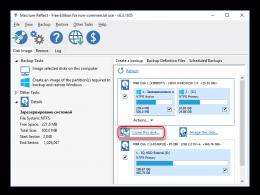Hidden settings for Android 5.1. How to open and configure the engineering menu on Android - instructions and secret codes
One of the most interesting places in the settings of your smartphone - this is the “For Developers” menu. By default it is hidden, but this can be easily fixed. Open Android settings, then go to the about phone section. Tap on the “Build number” line seven times and you will be notified that you are now a developer.

As a result of these manipulations, it will appear in the settings new section"For developers". Go into it and find the option “Enable 4x MSAA”. Activating it will allow you to achieve better rendering and, as a result, a better picture in . Just keep in mind that this only works on powerful modern devices that can handle detailed graphics.
View notification history
If you inadvertently brushed off an important notification before you even had time to read it, know that Android has a special storage for notifications. Getting to it is not at all difficult.


Open the add widgets menu and find the “Settings Shortcut” item. Drag it to your desktop and select “Notification Log” from the menu that appears. Using this widget, you can open the archive of notifications at any time and view the ones you need.
Removing unnecessary icons in the status bar
In Android Marshmallow, in the settings you can activate the System UI Tuner section, which contains options for changing the system interface. To do this, you need to open the top curtain and hold the gear icon for a few seconds. After this, a new section with the options we need will appear in the Android settings.


Open System UI Tuner and go to status bar options. Here you can disable icons that you do not want to appear in the status bar. In the same place there is an option that activates the display of the charge percentage on the battery icon.
Activating night mode
Google has long promised to implement Android special night mode, protecting our eyes from the glow of the screen when reading in the dark. In the new Android versions it appeared, but, unfortunately, is disabled for now. However, this problem can be easily solved using free utility.


The program has only one function: to activate the night mode hidden in Android 7.0. After applying it, a red filter enable tile will appear in the quick settings menu, and in the System UI Tuner described above - detailed settings night mode.
What little-known Android settings can you recommend?
IN Android Lollipop In addition to significant visual changes, many new features have been added, which we talk about in the series of articles “Learning Android 5.0.”
In today's review: new panel quick settings, search through them and select notification types (“Important”, “All” and “Do not disturb”), as well as configure them.
Read previous instructions for Android 5.0:
Search by settings

Now in the settings in the upper right corner there is a magnifying glass icon, clicking on which will open a search window. You only need to enter a query, and the system itself will display the sections where it occurs.
Quick settings panel
In Android 5.0 Lollipop, the notification panel has changed significantly and is now simply gorgeous. It is still called by swiping down from the very top of the screen (now this can also be done directly from the lock screen). In this case, the entire display area is darkened, but the curtain no longer reaches the end of the screen, as it was before, but consists of only the notifications themselves and the status bar.

If you swipe across the screen with two fingers or lower the already open notification shade, a quick settings panel will appear. From there you can enable/disable Wi-Fi, Bluetooth, airplane mode, auto-rotate screen, and geodata transfer. There you can adjust the brightness, find out the remaining battery charge in percentage and go to the settings menu.

To completely close the 2 panels, tap anywhere on the screen, and if you want to go only to notifications, swipe up.
Notification types: Important, All, and Do Not Disturb
Now by pressing the volume up or down button, 3 new items will appear. The default is “All”, that is, absolutely all notifications will be displayed. Selecting “Do Not Disturb” will turn them off completely. In addition, you can configure the duration of this option: indefinitely or for several hours (maximum 8).

But if you are waiting for a message from someone, a reminder or notification about an important event, you can turn on the “Important” option. By clicking on the settings icon, you will go to the “Alert Mode” item, where you can enable the option you need: “Events and reminders” and/or “Messages”. You can also set days and times when you want to show only important notifications.

By going to the system settings menu and opening “Sounds and notifications” - “Application notifications” you can turn off notifications specific application or vice versa, make them priority or confidential.

By making app notifications a priority, they will appear at the top of the list, and sensitive ones will not be shown when the device is locked.

The alarm you set will ring in any case—it cannot be turned off, regardless of the selected notification type.
Currently, the Android operating system is the most popular. It is installed on more than 1.2 billion devices worldwide. But few people know what this OS contains hidden possibilities. Internet project “Be Mobile” studied “ secret functions"and prepared a list of the most interesting of them.
1. Hidden mini-game
id="sub0">Starting with Android 2.3 Gingerbread, Google will put it on everyone Android smartphones, so called, " Easter eggs"- hidden secrets that can be seen by performing a series of non-obvious actions. Like the names of the OS versions, Easter eggs in it are also usually associated with sweets: in Android 4.1 Jelly Bean there were flying jelly beans, in Android 4.4 KitKat there was an OS logo in the style of the Nestle sweet of the same name, and in Android 5.0 Lollipop there was a hidden Flappy Bird style game. Android 6.0 Marshmallow has not been left out either.
To access the mini-game, open Settings. Go to “About phone” or “About tablet”. Quickly click on “Android Version” several times.




A marshmallow stylized as an android's head will appear on the screen. If you quickly click on it a few more times, a mini-game will open.
Like Android 5.0, the mini-game in Android 6.0 is in the style of Flappy Bird, but the lollipops are replaced with marshmallows in the shape of a robot head. The game has funny graphics and, although it looks simple, it is quite difficult to score at least 10 points in it. I got a maximum of 4 points. I couldn't do it anymore.
2. Remote control of a smartphoneid="sub1"> Lost Android mobile devices can be found and blocked, but Google hid this option quite deeply. It is activated in the menu“Settings -> Security -> Device Administrators” In chapter " Remote control
Android".
Activate extended rights for the device manager upon request. Now you can manage your device from google.com/android/devicemanager in your Google account or through the Android Remote Control application
People who are familiar with Android will easily restore deleted files, if you don't encrypt yours mobile device. To activate this option, open “Settings -> Security -> Device encryption”. Set up encryption.
3. Safe Mode
id="sub2">Another protective Android function is "safe mode". It deactivates everything third party applications. Moreover, in " safe mode"They can be deleted if for some reason they are incompatible with your mobile device, ended up in the boot loop by accident, or are Trojans or viruses.
To start “safe mode”, hold down the power button. When the menu for turning off the smartphone and activating airplane mode opens, hold your finger on the “Power off” item for a long time. Then confirm to boot into safe mode.




The smartphone will boot into “safe mode”. All third-party application icons will have grey colour. If something happens, you can safely remove them.
4. Synchronization and push notification settings
id="sub3">When installing certain applications, you don’t think about permissions to send push notifications or any others. Over time, these applications begin to spam you with unnecessary information. Games especially suffer from this, but it can also be quite regular applications. Luckily, notifications can be turned off.

To do this, open “Settings -> Applications -> All”, find the culprit and select “Notifications”. Here you can either disable all notifications at once (“Block All”), or allow only “swipe” notifications (“Short Notifications”), etc.
5. Advanced WLAN settings
id="sub4">On Android there is a settings section that is completely invisible to most users with additional Wi-Fi options. To get to it, you need to go to “Settings -> Wi-Fi”, then press the menu key and select “ Additional functions" Here you can turn off notifications about detected networks, turn off Wi-Fi in sleep mode, prohibit using Wi-Fi networks with a poor signal, and set up Wi-Fi Direct (direct pairing of devices without using an access point).


6. Setting up mobile Internet traffic control
id="sub5">In Android without third party programs Internet traffic can be monitored. For example, now many operators mobile communications provide a limited package of free traffic for a month. To control this traffic and not exceed the quota, or to understand how much traffic is left, you can set limits.

For this purpose, there is a separate “Data transfer” item in the settings. There you can set a traffic limit, upon reaching which a notification will appear, as well as a limit, after which data transfer will be automatically turned off. For each application, separate statistics are kept on data in background and active modes, and a graph is built. Starting from Android 5.0, this interface is also available in quick settings by touching the mobile network icon.
7. Block calls from specific numbers
id="sub6">It happens that you need to block calls from a specific number. There are no special blacklists in Android, but those available in Google Play applications implement blocking of numbers using dirty hacks and not always correctly.
However, blocking individual numbers can be obtained in the basic version of Android; to do this, simply send unwanted subscribers to voicemail. To do this, click on the desired contact, then click the edit icon, then the menu and select “Voice only.” mail". There, by the way, you can set a separate ringtone for the unfortunate subscriber.
8. Disabling pre-installed applications
id="sub7">It happens that the manufacturer preinstalls many incomprehensible programs and applications that you do not use. They occupy certain memory, and you dream of getting rid of them.
On Android, you can disable many pre-installed applications. To do this, go to “Settings -> Applications” and open the “All” tab. Now you can view the list of available utilities. Select the required application, and then click “Disable”. Now you can click on “Erase data”. For “frozen applications” that cannot be simply deleted, there is separate tab"Disabled." Unfortunately, not all applications can be frozen. Which ones depend on the manufacturer.
9. Expanding internal memory
id="sub8">Android has always had a problem with extensions internal memory smartphone. The connected SD card did not allow this, remaining external storage. The function of transferring applications to a memory card, which appeared in Android 2.2, also did not really save the situation. Finally, with Android 6.0, Google finally decided to correct the situation. Now, after connecting a flash drive or SD card, the system offers two options. The first is to use it as removable storage. The second is to make it an internal drive.
In the second case, the smartphone will format the flash drive in file system ext4 using 128-bit AES encryption and mounts it as system partition. Next, a test for reading and writing speed will be carried out. Now, unfortunately, all memory cards are significantly inferior in speed to built-in memory, which in theory can lead to slow operation of the device. Fortunately, only the time it takes to open a specific application or load part of it depends on the performance of the disk subsystem. And all calculations are carried out outside the disk.
10. Quickly change letter case
id="sub9">It happens that the text has already been written and you need to change the case of individual letters or entire words. Android has its own secret about this. To change the case of letters or make words or sentences in an already entered message begin with capital letters, just select the message and press the Shift button one or more times until you get the desired result.



11. Quick access to settings
id="sub10">In Android 5 and Android 6, access to quick settings can be achieved by pulling the curtain out with two fingers. Of course, you can access Quick Settings the old fashioned way: by swiping down from the top of the screen twice. But this is not a secret at all.
12. Quickly switch to silent mode
id="sub11">You can quickly turn on vibration mode in Android 5 and Android 6 by pressing the volume key and then clicking on the icon on the left side of the slider that appears. In practice, this option turns out to be much faster than repeatedly pressing the volume down key on the end of the smartphone.
13. Calling Magnifier
id="sub12">Android has a screen magnifier. To enable it, you need to sequentially go to “Settings -> Special”. options -> Gestures to zoom in.” Now you can enlarge any part of the screen by clicking on it three times. This feature may be especially useful among people with low vision and the elderly.


14. Disable adding shortcuts to the desktop
id="sub13">To disable automatic creation of desktop icons, run Play Store. Then go to settings and uncheck the “Add icons” option. Now, by default, program icons will appear only in the general list.
15. Hidden game in the Chrome browser
id="sub14">To conclude our selection, there is another hidden game, this time in mobile browser Chrome. Try turning off Wi-Fi and Mobile Internet on your smartphone (tablet). Next, open Chrome.


When you try to exit to any address, the browser will display an error with its code. A dinosaur will appear above the text. If you click on the dinosaur at this moment, the character will come to life and begin to move across the screen. It's like an old PlayStation: you can tap the screen to control a dinosaur as it jumps over cacti, and like any game like this, your goal is to hold out and score maximum amount points. Of course, the game is quite primitive, but it hooks you for a long time. Tested for yourself!
By the way, this game has now become available for download on the Google Play Store and it’s called Dino Run - Dinosty.
Why do you need rooting? Android devices and what opportunities it provides are known to a fairly large number of users, which cannot be said about the hidden advanced hardware settings menu, also called the engineering menu. Few people know about these settings, and even fewer mobile device owners know how to use them. What does it represent engineering menu Android and why is it needed?
The Android engineering menu is nothing more than a special subroutine designed for testing by developers operating system and device sensors. The interface of this program is represented by a set of options that allow you to change the hardware configuration of your mobile device. With its help, you can get comprehensive information about the hardware of the gadget, test the processor, RAM and physical flash memory, modes wireless connection, configure camera settings, display, microphone, speakers and much more.
Entering the engineering menu
All this, of course, is good, but here’s how to enter the engineering menu if Android interface there is no corresponding option? Enter the advanced hardware settings menu using special code, entered in the line to dial phone number. The menu should open immediately after entering the last character of the combination, but in some cases you may need to press the call button.
There is nothing complicated in the procedure itself, however, it should be taken into account that different models of mobile gadgets have their own codes. Below we have provided a list of codes for the most popular manufacturers.
Engineering menu codes in Android are universal, however, their correct operation on phones with “left” firmware is not guaranteed. To access hardware Android settings can also be used special programs, For example, "MTK Engineering Menu" or "Mobileuncle MTK Tools".

Such applications are especially useful on tablets whose firmware does not provide a dialer. The interface and set of available options in these programs are somewhat different, however, understanding them will not be difficult.
Whatever method you use, you need to exercise maximum caution when working with the engineering menu. Before starting work, it is strongly recommended that you write down all the initial parameter values so that you can restore the settings. It is unacceptable to experiment with the engineering menu just to find out what comes out of it, as you can render your device unusable!
To obtain a list of engineering codes for specific model phone can be used special application Secret Codes, available on Google Play. On some mobile device models, full access to the engineering menu may require superuser rights (root).
What you can change using the menu
You know how to get to the engineering menu, now let's find out what settings can be made using it. The possibilities are more than wide. The menu subroutine supports changing the speaker volume level and microphone sensitivity, built-in camera settings, audio parameters, GPS, Bluetooth and Wi-Fi modules, and turning off unused frequencies to save battery power. You can also test the key components of your device and external card memory, configure I/O operations, determine the exact temperature of the processor and battery, and the level of harmful electromagnetic radiation.
Another useful function is to gain access to recovery mode - an analogue of BIOS on computers, which in turn contains a whole set of settings. Recovery mode features include resetting the device to factory settings, updating firmware, creating backup copy operating system, gaining access to root rights, deleting confidential user data. It is not possible to list all the engineering menu options in one article; the more sensors and components there are in a phone or tablet, the more extensive it will be.
Increasing phone volume through the engineering menu
Now let’s demonstrate how to work with hardware settings using the example of one of the most popular operations and learn how to increase the volume on Android through the engineering menu. So, go to the menu using Mobileuncle MTK Tools or by entering the “magic” code, then find and open the Audio subsection. If you entered the menu through the Mobileuncle Tools program, this subsection will be located in the senior section Engineer Mode, in other cases it is usually located on the Hardware Testing tab.

In the Audio subsection you will have the following options:
- Normal Mode – normal mode that works when a headset is not connected to the device.
- Headset Mode – headset mode that turns on when headphones or speakers are connected to the smartphone.
- LoudSpeaker Mode – loudspeaker mode. Activated when turned on speakerphone provided that there is no headset connected to the device.
- Headset_LoudSpeaker Mode – loudspeaker mode with a connected headset. The same as the previous one, but with headphones or speakers connected.
- Speech Enhancement - this mode is activated when talking on the phone without using the speakerphone.

There may be other settings in the section, for example, Debug Info and Speech Logger, but it is better not to touch them. Select the mode for which you want to change the volume level (let it be Normal Mode), select Type in the list that opens and indicate for which function we will change the volume. The following functions may be available:
- Ring – adjust the volume for incoming calls;
- Media – adjust the speaker volume when playing multimedia;
- Sip- sound settings for Internet calls;
- Sph – sound settings of the conversational speaker;
- Sph2 – sound settings of the second speaker (the option may not be available);
- Mic – change the microphone sensitivity;
- FMR – FM radio volume settings;
- Sid – it is better not to touch this parameter, otherwise problems with the interlocutor’s voice may occur.
Having selected a function, scroll through the current list and set desired value Value (from 0 to 255) and click to apply the new Set settings.

To change the volume level, you can also use preset templates - the Level option. Most phones have seven levels, from 0 to 6. It is advisable not to touch the Max Vol setting, just as you should not set the Value values too high, otherwise the sound in the speakers will begin to wheeze. Other modes in the Audio subsection are configured in a similar way.
Some smartphone and tablet models require a reboot for the new settings to take effect.
Reset
And the last thing we will look at today is resetting the engineering menu parameters to factory values. It may be needed if, after making changes, the device begins to work incorrectly. There are several reset methods. If the system boots normally, go to the settings and open the “Backup and Reset” subsection.



You can also reset the engineering menu by entering a special service code in the dialer. Usually it is *2767*3855#, *#*#7780#*#* or *#*#7378423#*#*, but your phone model may require a different code.
Another option is to use the recovery mode mentioned above. To get into it, use one of these combinations:
- Power button + volume down.
- Power button + volume up.
- Power button + Home button + Volume down/up.
- Power button + volume up + volume down.
In the list of options that opens, select “wipe data/factory reset” → “Yes – delete all user data” → “reboot system now”. The device will reboot and the settings will be reset.



There is another way to reset the engineering menu settings, but it requires superuser rights. Using any file manager with the support root rights, go to the root directory of the system, and then delete all or part of the contents of the folder data/nvram/apcfg/aprdcl and reboot.

Files in a folder aprdcl they are responsible for setting up the engineering menu. It is not necessary to delete all files at once. If you mess up, say, your audio settings, all you need to do to restore the original settings is delete files that have an audio string element in their names. And one moment. Regardless of the reset method, always make a backup of your personal data and applications, as they may all be lost.
Manufacturers of Android smartphones implement and use the engineering menu to test devices. It contains all kinds of tests and device settings that are not available to ordinary users. However, today, knowing the USSD command or downloading the application from PlayMarket, anyone can go to the engineering menu.
Why do you need a hidden engineering menu in Android?
Engineering menu (Engineering Mode) – at its core hidden application, which developers use to test and set optimal parameters mobile phone or tablet. Specialists check the operation of the sensors and, if necessary, make adjustments to the functioning of system components.
When working with the Android technical menu, be careful - changing some functions leads to malfunctions of the device.
How to enter the menu
To open the menu installed by the manufacturer, activate the dial pad on your smartphone and enter one of the USSD commands presented in the table. After entering the command, the numbers will disappear from the screen, and a menu will open instead.
Table: combinations for launching Engineering Mode
Video: how to work in Engineer Mode
If the code does not work and in a standard way It is not possible to launch the service menu, use third-party applications - you can download them on PlayMarket. Recommended programs - “Launch the MTK engineering menu”, Mobileuncle Tools, Shortcut Master.
The manufacturer menu does not work on some device models with Android 4.2 JellyBean (x.x.1, x.x.2), as well as on Android 5.1 Lollipop. The menu is also invalid when installed firmware Cyanogen Mod. In Android 4.4.2, when you reboot, changes made in the application are reset.
“Launch the MTK engineering menu”
The application allows you to open and configure the engineering menu without typing digital commands. Works correctly on MediaTek processors (MT6577, MT6589, etc.) and Android systems 2.x, 3.x, 4.x, 5.x. According to user reviews, the program successfully performs its functions, but after rebooting the smartphone, the settings made using the application are reset.
Mobileuncle Tools program
The functionality of the application is similar to the previous one, but, in addition to accessing the engineering menu, the user has the opportunity to view information about the screen, sensor and device memory, as well as update the firmware, restore the IMEI number and improve GPS. For stable operation, root rights are required.
Shortcut Master utility
The Shortcut Master program is designed to work with shortcuts and system applications: creation, search, deletion. It does not have a direct function for entering the engineering menu. But with its help you can view the list of secret commands operating on your device. And by clicking on the name of the command, you will see a drop-down menu in which there will be an item “execute”. Convenient and does not require unnecessary actions.
Root rights to access the engineering menu
To get to the service menu on some versions of Android, the user must have superuser rights (root). You can obtain rights using specialized applications: Farmaroot, UniversalAndRoot, Romaster SU and others. To get Root access to your device using Farmaroot:
Possible problems and solutions:
What can be configured in the menu
The appearance of the engineering mode and the ability to adjust parameters may vary depending on the tablet or smartphone model. In the menu, users most often adjust the sound, change camera settings and use recovery mode. The parameters for adjustment and the procedure are given below. Be careful - menu item names may vary depending on various models devices! You act at your own risk.
Audio: Increase volume level
If your phone does not ring loudly enough, find the Audio section in the engineering menu and go to LoudSpeaker Mode. Select Ring. For each signal level (level 1–6), change the values - set the numbers in ascending order, from 120 to 200. Increase the value in the Max item. Vol - maximum 200. Press the SET button to save the settings.
Audio: Increase phone call volume
To enhance the speaker tone for conversations, see service menu Audio select Normal mode and open Sph. Set the values for signal levels (level 1–6) from 100 to 150, and the number for Max. Vol. – up to 160.
To increase the sensitivity of the microphone, go to the menu Audio - Normal mode - Mic. For each level, assign the same microphone sensitivity values, for example, 200. Press the SET button, reboot and check whether the other party can hear you better.
Video: adjusting sound parameters in the engineering menu
Battery: Disable unused frequencies
Smartphones quickly consume battery life running applications, maintaining cellular communication And network connections. Using the engineering menu you can increase the battery life.
Modern devices scan several GSM frequencies - 900/1800 MHz and 850/1900 MHz. In Russia there is a 900/1800 MHz pair, which means there is no need to scan the network at other frequencies. The radio signal for the second pair can be turned off, which will significantly save the charge level.
In Engineer Mode, open Band Mode. Disable unused frequencies by unchecking the corresponding items - PCS1900 and GSM850. If the device supports two SIM cards, open the SIM1 and SIM2 items one by one and perform the indicated steps in each. Press the SET button to save the settings.
If your smartphone and SIM card operate in 3G networks, disable the networks that are not used in Russia: WCDMA-PCS 1900, WCDMA-800, WCDMA-CLR-850. Press the SET button again.
You can enable scanning of disabled networks by returning to the same menu and checking the boxes.
Camera: photo and video settings
By default, Android devices save pictures in JPEG format. Meanwhile, photographers prefer to shoot and process material in RAW to gain more editing options. The technical menu allows you to select the desired image format.
Find Camera in the menu and select Capture Type. Set the photo format to RAW and press SET. Also in the Camera menu you can increase the size of pictures, set the ISO value, enable shooting in HDR for higher photo detail, and set the frame rate for videos. After changing each parameter, remember to press SET to save the settings.
Recovery Mode
Recovery Mode(Recovery mode) – analogous to Bios on a computer, allows you to control the device without logging into Android system. Recovery mode features:
In Recovery Mode, do not perform an action if you are not sure what it will lead to. Some commands may harm the device and system.
If the settings are not saved
Users who have access to the technical menu complain that the parameters changed in it are not activated or are reset when the device is restarted.
To activate the settings after changing the parameters, tap on the SET button at the bottom of the screen. If the parameters are reset after rebooting the device, try accessing the technical menu not through the application, but using a digital command.
Service codes for Android devices
In addition to the technical menu, secret USSD codes - combinations of numbers and symbols, which the user types by typing to perform an action, allow you to control the functionality of Android smartphones. Secret codes for different devices are given in the table.
Table: list of secret commands for Android
If for some reason the service code did not work, do not worry - install and run the Secret Codes application (Link on Google Play: https://play.google.com/store/apps/details?id=fr.simon.marquis. secretcodes&hl=ru).
The program will analyze the combinations active in the device and offer you a list. You can activate the combination directly in the application with one click on the name. There are many ways to improve your Android mobile device using the engineering menu. The menu structure varies depending on different models devices, but the basic functionality is preserved everywhere. When opening and changing parameters in the service section, be careful - some commands lead to system failures






